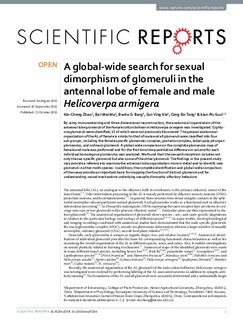| dc.contributor.author | Zhao, Xin-Cheng | |
| dc.contributor.author | Ma, Bai-Wei | |
| dc.contributor.author | Berg, Bente Gunnveig | |
| dc.contributor.author | Xie, Gui-Ying | |
| dc.contributor.author | Tang, Qing-Bo | |
| dc.contributor.author | Guo, Xian-Ru | |
| dc.date.accessioned | 2017-12-12T09:53:34Z | |
| dc.date.available | 2017-12-12T09:53:34Z | |
| dc.date.created | 2016-10-13T16:09:48Z | |
| dc.date.issued | 2016 | |
| dc.identifier.citation | Scientific Reports. 2016, 6, 35204 | nb_NO |
| dc.identifier.issn | 2045-2322 | |
| dc.identifier.uri | http://hdl.handle.net/11250/2470601 | |
| dc.description.abstract | By using immunostaining and three-dimensional reconstruction, the anatomical organization of the antennal lobe glomeruli of the female cotton bollworm Helicoverpa armigera was investigated. Eighty-one glomeruli were identified, 15 of which were not previously discovered. The general anatomical organization of the AL of female is similar to that of male and all glomeruli were classified into four sub-groups, including the female-specific glomerular complex, posterior complex, labial-palp pit organ glomerulus, and ordinary glomeruli. A global-wide comparison on the complete glomerular map of female and male was performed and for the first time the quantitative difference in volume for each individual homologous glomerulus was analyzed. We found that the sexual dimorphism includes not only the sex-specific glomeruli but also some of the other glomeruli. The findings in the present study may provide a reference to examine the antennal-lobe organization more in detail and to identify new glomeruli in other moth species. In addition, the complete identification and global-wide comparison of the sexes provide an important basis for mapping the function of distinct glomeruli and for understanding neural mechanisms underlying sexually dimorphic olfactory behaviors. | nb_NO |
| dc.language.iso | eng | nb_NO |
| dc.publisher | Nature Publishing Group | nb_NO |
| dc.rights | Navngivelse 4.0 Internasjonal | nb_NO |
| dc.rights.uri | http://creativecommons.org/licenses/by/4.0/deed.no | |
| dc.title | A global-wide search for sexual dimorphism of glomeruli in the antennal lobe of female and male Helicoverpa armigera | nb_NO |
| dc.type | Journal article | nb_NO |
| dc.type | Peer reviewed | nb_NO |
| dc.description.version | publishedVersion | nb_NO |
| dc.source.volume | 6 | nb_NO |
| dc.source.journal | Scientific Reports | nb_NO |
| dc.identifier.doi | 10.1038/srep35204 | |
| dc.identifier.cristin | 1391573 | |
| dc.description.localcode | © The Author(s) 2016. Published by Nature Publishing Group. This work is licensed under a Creative Commons Attribution 4.0 International License. The images or other third party material in this article are included in the article’s Creative Commons license, unless indicated otherwise in the credit line; if the material is not included under the Creative Commons license, users will need to obtain permission from the license holder to reproduce the material. To view a copy of this license, visit http://creativecommons.org/licenses/by/4.0/ | nb_NO |
| cristin.unitcode | 194,67,40,0 | |
| cristin.unitname | Institutt for psykologi | |
| cristin.ispublished | true | |
| cristin.fulltext | original | |
| cristin.qualitycode | 1 | |

